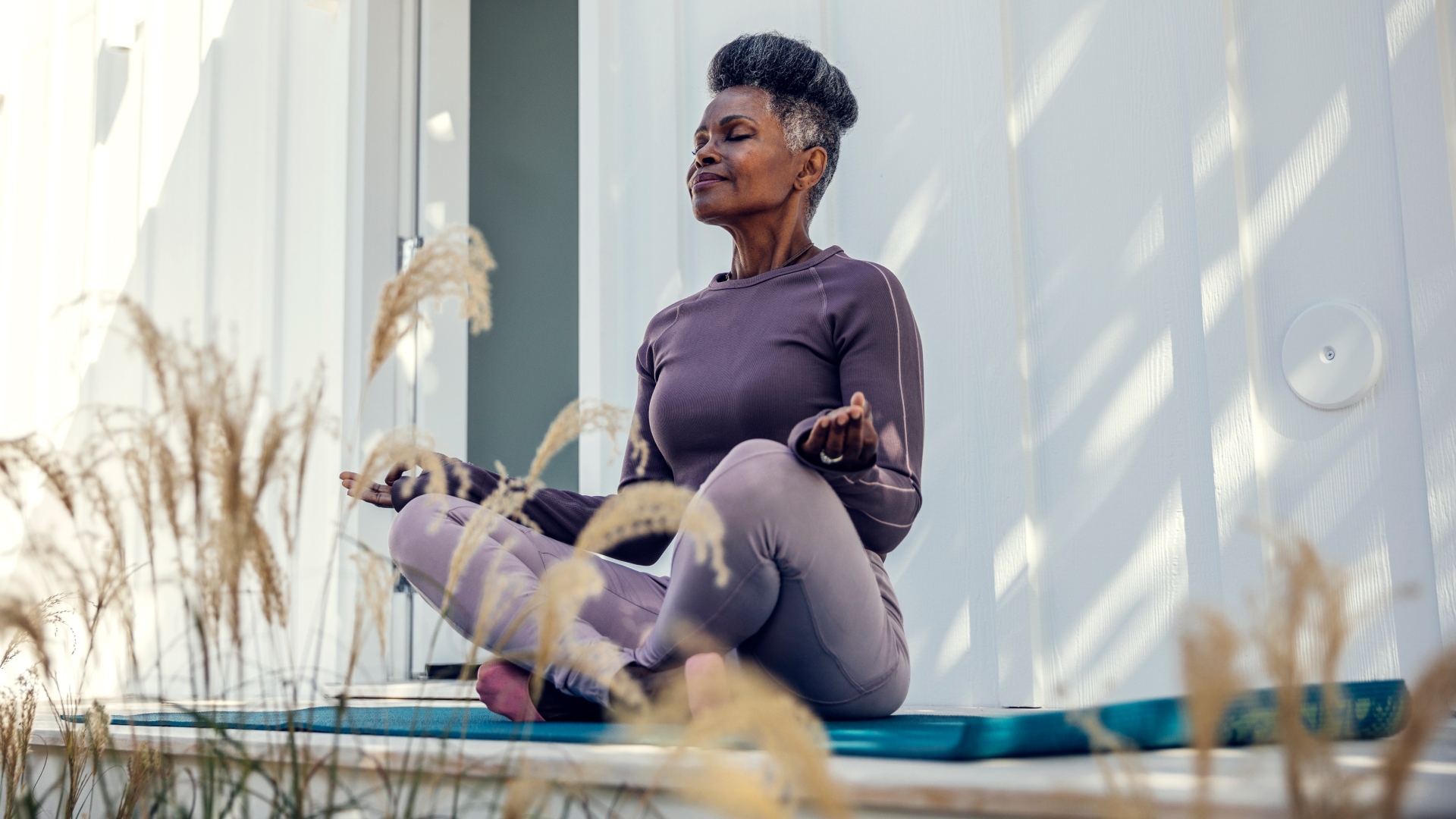What is shadow work? A guide to self-healing with helpful methods you can try at home
Embracing shadow work and learning how to implement self-healing is a vital element in your self-development, says Fiongal Greenlaw


With the Autumn Equinox behind us and the days getting distinctly shorter, our collective minds turn to the darkness, making this time of year ideal for embracing shadow work.
The shadow self is a concept coined by the famous psychiatrist Carl Jung who, you may be surprised to hear, was also a big fan of tarot cards. The shadow self is the aspect or aspects of ourselves that we consider unacceptable. We can identify our own because the emotions attached to it are things like sadness, anger, jealousy, abandonment, and fear. These feelings are frequently difficult to face and process, meaning we either ignore them, suppress them, or both. This concealment is particularly true if these emotions don’t align with the way we would like to perceive ourselves - or how we want to present ourselves to the world. For instance, a person who believes they, "never get angry," will avoid conflict at any cost. That is because dodging a challenging confrontation is much easier than a situation that might contradict their sense of being a, "calm and collected person."
Ultimately, the shadow is the blind spot of our psyche. If we are fully accepting and honest with these parts of ourselves, they wouldn’t hold the same power and potency as they do. Let’s take the example of someone saying to you, "you’re always late." If you know you’ve let your time-keeping slip of late, but in your heart, you know yourself to be reliable, dependable, and punctual, you’ll shrug this accusation off. Yet, this comment might sting if you’ve been carrying some recent guilt about letting people down or you have a long history with others not seeming to value your time. In the latter instance, you’re likely to snap at the person who dared make such a remark to you!

Our shadow, however, isn’t always born from our own issues. The need for shadow work can arise from the social mores we feel obliged to follow. For example, public opinion on marriage varies wildly from culture to culture. Polygamy is criminalized in some parts of the world and openly promoted in others. Yet, if a personal preference goes against the social grain, we have little room to experiment with and explore these parts of ourselves. So instead, we hide them away and repress them.
In the many years, I’ve been doing one-to-one psychic readings, I’ve witnessed nothing more corrosive or damaging than secrets. People spend so much time and energy protecting these sides to themselves at all costs. Much like a parent might cling to a newborn child. The fear that someone else might out their secret without their say-so, causes much anxiety, stress, and sometimes mistrust of others.
Examples of Shadow Self
Our shadow side can present itself when we are triggered, have feelings of shame or guilt, or self-sabotage. The self-saboteur is someone who unconsciously destroys what they’ve accomplished and achieved out of a lack of confidence and fear of their own success. Anyone who has watched Ru Paul’s Drag Race will have heard RuPaul Charles himself utter the term ‘your inner saboteur’ time and time again.
Here are some other examples of how the Shadow Self might reveal itself:
Sign up for the woman&home newsletter
Sign up to our free daily email for the latest royal and entertainment news, interesting opinion, expert advice on styling and beauty trends, and no-nonsense guides to the health and wellness questions you want answered.
- The victim emphasizes and blames external events as a justification not to move forward with life.
- The workaholic will side-line friends, families and other responsibilities for the sake of success and achievement.
- The gossip garners social status and importance by betraying confidence and trust.
- The rebel who bucks and challenges legitimate authority out of anger and obstinance.
- The innocent who is easily affronted and shocked as to retain a sense of self-righteous virtue.
Is our Shadow Self bad?
No. First and foremost, we all have a shadow self. The shadow self exists in everyone, as we all have these blind spots. It is neither negative nor positive; it simply is. However, recognising and truthfully examining the parts of ourselves that we’re ashamed of can lead to a greater understanding of who we are. Our shadow tells us what we need to integrate into our conscious selves to allow growth and healing. Although this process can be challenging and requires us to be honest with ourselves, it is greatly rewarding because it leads to wholeness and a sense of inner peace. Sounds great, huh? So how do we do this?
One of the most memorable and captivating scenes from Peter Pan is in his first encounter with Wendy when he is separated from his shadow. In the Disney movie, his shadow is depicted as a trickster and prankster.This is the perfect way to look at our shadow self. Not with cheerlessness and a sense of foreboding, but rather as a mischievous thing that likes to play tricks on us!
Throughout literature, the shadow is used as a symbol of an extension of oneself and the soul. In Jewish folklore, demons are believed to have no shadows. Without shadows, a person is lacking or not human. So, our shadow side is as much a part of us as the light–they are two sides of the same coin.
Finding your Shadow Self

First, we need to identify the shadow parts of ourselves. As I explained before, your shadow side is the blind spot in our psyche, and, at times, it will purposely deceive you to protect itself. Thoughts like, ‘I can’t change it anyhow’ or, ‘I don’t have much of a shadow side’ are indicators that you’re getting closer to it. But it may do everything in its power to dissuade you from looking further. Below are some failsafe techniques to help you spot your shadow self:
1. Use shadow work prompts
In a journal to understand your core beliefs, thoughts, and feelings. There are plenty of ideas on the internet, but here are a few you might want to consider:
- What beliefs have I inherited from my family that do not serve me? For example, "Money doesn’t grow on trees," or, "You can only rely on yourself."
- What parts of myself do I try to hide from others?
- What personality traits bother me?
- What patterns of behavior don’t I like in myself?
- Am I got at prioritizing myself?
2. Pay attention to your dreams and nightmares
This is where the conscious mind quietens, allowing you to recognize what your subconscious mind is telling you. Understanding the meaning of dreams can be a puzzle in itself, but it can be a window into the subconscious.
3. Look at your triggers
Going back to the illustration of, "you’re always late," if you feel a surge of annoyance or shame, this indicates that something beneath it needs resolving within yourself. By doing the shadow work necessary you may better learn how to deal with stress.
4. Identify your fears and insecurities
Grab your nearest notepad and spend some quiet time listing the things that bring you the most anxiety in life and why. Anything and everything will be relevant and perhaps, if you're struggling to come up with anything straight away - just write about your day for five minutes as a warm up exercise.
5. Speak to a professional
The mere thought of tackling the above minus support could leave anyone wondering how to deal with loneliness. Luckily, it's possible to find the right kind of a guide for you. Be that a therapist, counsellor, coach or psychic - they're there to listen and learn about the things that bother you.

Self-healing: How to implement it into your life
So, we’ve brought to light where your shadow self might be lurking; how do you integrate it? Below are 6 easy-to-follow steps on how to do shadow work.
1. Gratitude
Gratitude is one of the most healing forces in the Universe. Write a letter to your shadow side expressing your thanks and appreciation for the things it's taught you about yourself. Then write a list of all the things you are grateful to yourself for, all your best qualities, your accomplishments and your generosity to others. Then write a letter of gratitude to the Universe for all the abundance and lessons its given you.
2. Meditate
Sometimes, just sitting in stillness is the best thing we can do for ourselves. It also brings about incredible self-awareness as the 'monkey chatter' mind, our everyday mind, settles down. Holding a piece of rose quartz crystal, one of the most healing types of crystals, and setting the intention of softening your shadow self is an incredibly powerful tool. This will set the stage for significant breakthroughs and emotional healing.
3. Do a Tarot/Oracle reading for yourself:
Well, if they're good enough for Jung, they're good enough for you too! Lay down a spread with the intention of the cards showing you your shadow side.
Lay three cards representing your shadow. Lay down three more cards, asking the deck, what is blocking you from resolving your shadow? Then lay down the final three cards, asking the deck how to overcome these shadows.
4. Connect with your inner child
Take a photo or object from your childhood and have a conversation with your younger self. Address all the things you found difficult, challenging or confusing at that age. Comfort and reassure your younger self that they will be fine, and these challenges are what made you the person you are and stronger for it.
5. Connect with your inner critic
Pull out your journal, and free write a letter from your worst critic to you. In this, I want you to write down why you will not achieve what you want, your shortcomings and your fears. Then I invite you to write a letter back to your harshest critic explaining all the reasons that they are wrong.
6. Be playful
Often, we can take ourselves so seriously - don’t forget to have fun! It’s impossible to be light-hearted and sombre at the same time. One great technique is to objectify your shadow self and give it a silly name or voice, so when it comes creeping in, you can think, “Oh, here comes Moaning Martha again with her unhelpful opinions!” It’ll take the wind out of the sails of your inner critic.

Fiongal is the founder of The Wellness Foundry. Having read for hundreds of clients, he blends Tarot, Psychicism, and Mediumship to give you an in-depth reading, exploring every aspect of your life. He offers an Aura diagnosis, so that you may better understand your energetic makeup and health. Then he works with his Guides to give you honest, yet compassionate, accurate guidance, and reassurance.
-
 Smeg's retro hand mixer puts the 'king' in baking - I'm convinced it's the best
Smeg's retro hand mixer puts the 'king' in baking - I'm convinced it's the bestThe Smeg 50s Style Hand Mixer is every keen baker's dream: it whips up cream, mixes cookie dough, and kneads bread like the best hand mixers on the market
By Laura Honey Published
-
 From highlights to glosses, here's everything you should know before colouring Afro-textured hair
From highlights to glosses, here's everything you should know before colouring Afro-textured hairKeep your curls and coils healthy during colour processes with this beauty editor's guide
By Keeks Reid Published